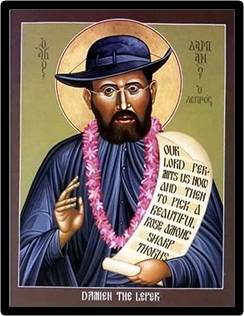APRIL 15 - BLESSED DAMIEN OF MOLOKAI

Joseph “Jeff” de Veuster was the son of Belgian farmers. He and his brother, Pamphile, grew to be strong and healthy young lads working on the family farm. Everybody liked Jeff because he was good-natured and generous.
When they were old enough, both brothers became missionaries and joined the congregation of the Sacred Hearts. These missionaries were responsible for the Catholic faith on the Hawaiian Islands. Jeff chose the name “Damien.”
More missionaries were needed in the kingdom of Hawaii. In 1863, a group of Sacred Hearts priests and brothers were chosen to go. Pamphile, Damien’s brother, was selected. But just before the departure date, Pamphile had typhoid fever and he had to give up his dream of being a missionary.
Brother Damien, still studying to become a priest, asked if he could take Pamphile’s place. The father general agreed to let Damien go instead. He went home to his family for a loving farewell. Then he took the ship from Belgium to Hawaii, a journey of eighteen weeks.
Damien finished his studies and was ordained a priest in Hawaii. He spent eight years among the people of three districts, traveling on horseback and by canoe. The people loved this tall, generous priest. He used the little money he could raise to build chapels. He and volunteer parishioners built the chapels themselves.
But the most incredible part of Damien’s life was about to begin. The bishop asked for a volunteer priest to go to the island of Molokai. Just the name of this place struck the people with fear and dread. They knew that the part of the island called Kalawao was the “living graveyard” of people dying of leprosy.
There was so much that people did not know about leprosy and they were so frightened they too would get the disease, that lepers were mostly left alone to take care of themselves. It was a hopeless situation. There was no priest, nobody to keep law and order on Molokai and no health-care facilities.
The Hawaiian government sent some food and medical supplies, but it was not enough for the people there. And there was no system to make sure everybody on Molokai received what was distributed.
Father Damien went to Molokai. Faced with the poverty, corruption and despair, even Damien was shocked. But he made up his mind that for him there was no turning back. The people desperately needed help.
He went to Honolulu to deal with the health authorities. They told him that he could not travel back and forth to Molokai or he could spread the disease. Actually they didn’t want him on Molokai because he was creating too many problems for them.
So Damien had to make a choice: if he went back to Molokai, he could never leave. The health authorities didn’t know Damien. He chose to stay on Molokai.
He worked hard for eighteen years and with the help of the lepers and generous volunteers, Molokai was transformed. The word Molokai took on a whole different meaning. It became an island of Christian love.
Damien organized burial details and funeral services, so that death might have some dignity. He taught the people how to grow crops and feed themselves better. He organized a choir, and got persons to sing who had not sung in years. He gave them medical attention.
There was already a small chapel on the island but it soon proved too small. So with the help of patients he built a larger one, which soon overflowed every Sunday. Father Damien in the end became a leper himself. He died on April 15, 1889, at the age of forty-nine and was buried there. He was proclaimed “blessed” by Pope John Paul II in 1994.
